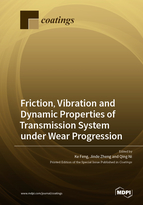Friction, Vibration and Dynamic Properties of Transmission System under Wear Progression
A special issue of Coatings (ISSN 2079-6412). This special issue belongs to the section "Tribology".
Deadline for manuscript submissions: closed (30 September 2022) | Viewed by 19109
Special Issue Editors
Interests: wear analysis; signal processing; vibration analysis; dynamics
Special Issues, Collections and Topics in MDPI journals
Interests: condition monitoring; wear analysis; nonlinear dynamics
Special Issues, Collections and Topics in MDPI journals
Interests: fault diagnosis; RUL prediction; vibration analysis; signal processing; machine learning
Special Issues, Collections and Topics in MDPI journals
Special Issue Information
Dear Colleagues,
We would like to invite you to submit your work to this Special Issue on “Friction, Vibration and Dynamic Properties of Transmission System under Wear Progression”. The transmission system plays a vital role in a range of industry transmission systems, including wind turbines, vehicles, mining and material handling equipment, offshore vessels, and aircraft. Surface wear is an inevitable phenomenon during the service life of transmission systems (such as gearbox, bearing and shafts), and wear propagation can reduce the durability of the contacting surface with coatings. As a result, the performance of the transmission system will degrade significantly, which can cause a sudden shutdown of the whole system and lead to unexpected economic loss and accidents. Therefore, it is necessary to investigate the friction, vibration, and dynamic property of contact coating surfaces and monitor the operating conditions of the transmission system for health management. This Special Issue aims to collect the latest developments in this area, with special emphasis on wear and fatigue analysis, dynamic property of coating surfaces in transmission systems, as well as non-destructive condition monitoring for the health management of transmission systems. Contributions from academic research, application-oriented research, and industrial field studies are welcome.
Potential topics include but are not limited to the following:
- Wear and fatigue analysis of transmission systems;
- Dynamic property of transmission systems;
- Surface degradation monitoring;
- Vibration analysis of transmission systems;
- Friction, corrosion properties of metal coating in transmission systems;
- Modeling analysis of transmission systems under wear progression;
- Intelligent techniques for monitoring system degradation behaviors.
Dr. Ke Feng
Dr. Jinde Zheng
Dr. Qing Ni
Guest Editors
Manuscript Submission Information
Manuscripts should be submitted online at www.mdpi.com by registering and logging in to this website. Once you are registered, click here to go to the submission form. Manuscripts can be submitted until the deadline. All submissions that pass pre-check are peer-reviewed. Accepted papers will be published continuously in the journal (as soon as accepted) and will be listed together on the special issue website. Research articles, review articles as well as short communications are invited. For planned papers, a title and short abstract (about 100 words) can be sent to the Editorial Office for announcement on this website.
Submitted manuscripts should not have been published previously, nor be under consideration for publication elsewhere (except conference proceedings papers). All manuscripts are thoroughly refereed through a single-blind peer-review process. A guide for authors and other relevant information for submission of manuscripts is available on the Instructions for Authors page. Coatings is an international peer-reviewed open access monthly journal published by MDPI.
Please visit the Instructions for Authors page before submitting a manuscript. The Article Processing Charge (APC) for publication in this open access journal is 2600 CHF (Swiss Francs). Submitted papers should be well formatted and use good English. Authors may use MDPI's English editing service prior to publication or during author revisions.
Keywords
- surface wear
- wear and fatigue analysis
- transmission system
- condition monitoring
- non-destructive condition monitoring
- friction








